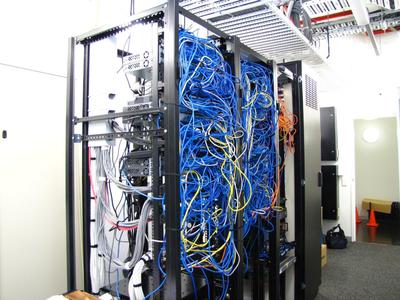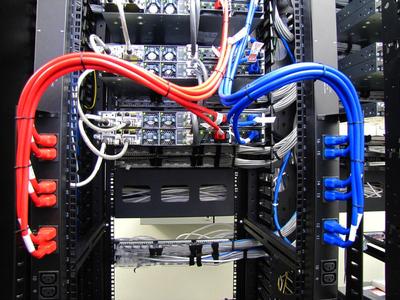The devil is in the detail
Wednesday, 12 December, 2012
When Lanec Services was asked to “tidy up” a five-year-old comms room install for a Victorian Government department, the decision to use self-tracing leads was a fairly obvious one. As with many IT installations, the project had grown unchecked over time and would likely require that cables be added, moved or removed altogether in the future. Therefore, the ability to quickly identify leads was a pretty clear requirement. Lanec Services Director Brett Lynton tells us more about the process.
“If there’s one thing we have learned in all the years of taking on projects of this nature, it’s that smart people learn from their mistakes, but really smart people learn from other people’s mistakes. In tidy-up jobs, the devil is in the detail. To us, comprehensive planning is everything and that’s really become the Lanec Services philosophy.”

The planning began with development of scaled drawings of the site, which allowed the team to determine what rack equipment to recommend based on clearances from switchboards and other essential equipment.
Once the equipment list was finalised and a full scope of works drawn up, planning moved to the finer details. Cabinet drawings were produced, showing both existing and proposed positioning of switches and where patch panels would be reinstalled determined by the length of the cabling.
“Installs of this nature typically work to pretty tight time frames,” explains Brett. “The client can rarely afford to be offline for more than, say, 12-24 hours. For this project, we were given a window of just under a day to deploy the entire solution. It becomes a case of carrying out as much prefab, off-site work as possible, allowing us to make the most of every available minute on site.”
Based on the cabinet drawings, the team was able to build a mock-up layout of the rack with switches and patch panels on their own premises. This process allowed for accurate measurement of each patch lead required and for this to be noted in the audit documentation. Pre-measurement prevents not only overall cable wastage, but also the need to deal with excess material in the vertical cable managers.
Racks, cabinets, power rails and cable managers were all ordered and delivered to the Lanec Services offices so that off-site preparation works could commence. By building racks at the office, mounting the power rails to the racks and even fitting captive plugs to the power rails, the amount of rubbish that ends up on site is reduced.
“Cardboard finds its way to recycling, plastic rubbish is dealt with appropriately and pallets are stacked and ready for return to the recyclers,” says Brett. “Clients really appreciate not being left with the onus of rubbish removal. It’s just one more thing they don’t have to think about.”
Two weeks out from deployment, the team undertook an audit of the existing patching. The only option was to employ hand-over-hand tracing by two experienced technicians, who fully recorded the results. According to Brett, this is a slow and painful process.
“You can’t rush tracing, as you need accurate results,” he explains. “It took a full 24 hours to audit and document the 350 leads involved in the project - that’s about four minutes per lead to trace and record. We also had to tag each lead to ensure we had itemised absolutely everything. It’s time-consuming stuff.”
Once all of the preconfigured equipment was shipped to site, the pressure was on to maintain the pace and meet the deadline. After stripping out old patch leads and removing existing equipment and racks, the first priority was to put the new racks into position and install switches and equipment.

Different coloured power leads were used so that the installer could quickly visually establish that dual-feed equipment had been cabled to separate power rails. Once this was done, patching through the uplink connections was carried out, enabling overall visibility. The audit sheets provided guidance for installation of the correct pre-measured patch lead.
The main aim for Lanec Services in a project of this nature is for the client to be able to commence testing with a minimum delay. Brett explains: “We had some of our guys on site on Monday morning, in the event that they were required. We took it as a good sign that the client technician had time to read the paper and enjoy a morning coffee post-testing!” he says.

“We also took the opportunity to re-audit the site at this stage, to determine the time benefit associated with using self-tracing leads. The simplicity of a single button press activating LEDs at both ends of the lead makes a huge difference in terms of traceability. Amazingly, the job which had taken 24 hours to audit initially was completed in less than three hours. That’s a massive time and labour saving to us, and to the client.”
To see the project unfold from start to finish, search on YouTube: Data Centre Cabling Clean-up By Lanec Services.
Thought Leaders 2025: Miroslav "Miki" Vuruna
Net zero, geopolitical risks and cybersecurity: Warren & Brown's Engineering and R&D...
Powering data centres in the age of AI
As data centres are increasingly relied upon to support power-hungry AI services and...
Smart cities, built from scratch
With their reliance on interconnected systems and sustainable technologies, smart cities present...




